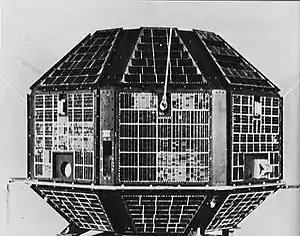RISAT-2
RISAT-2, or Radar Imaging Satellite-2 was an Indian radar reconnaissance satellite that was part of India's RISAT programme. It was built by Indian Space Research Organisation (ISRO) and successfully launched aboard a PSLV-CA rocket at 01:15 UTC on 20 April 2009 from the Second Launch Pad at the Satish Dhawan Space Centre.[2]
| Names | Radar Imaging Satellite-2 |
|---|---|
| Mission type | Radar imaging (Reconnaissance and disaster management) |
| Operator | Indian Air Force ISRO |
| COSPAR ID | 2009-019A [1] |
| SATCAT no. | 34807 |
| Website | www |
| Mission duration | 5 years (planned) 11 years, 9 months, 10 days (elapsed) |
| Spacecraft properties | |
| Bus | RISAT |
| Manufacturer | ISRO (satellite) IAI (sensor) |
| Launch mass | 300 kg (660 lb) |
| Power | 750 watts |
| Start of mission | |
| Launch date | 20 April 2009, 01:15 UTC |
| Rocket | PSLV-CA C12 |
| Launch site | Satish Dhawan, SLP |
| Contractor | ISRO |
| End of mission | |
| Last contact | 2020 (planned) |
| Orbital parameters | |
| Reference system | Geocentric orbit |
| Regime | Sun-synchronous orbit |
| Altitude | 440 km (270 mi) |
| Inclination | 41.2° |
| Period | 93.0 minutes |
RISAT-2's main sensor was an X-band synthetic-aperture radar (SAR) from Israel Aerospace Industries (IAI).[3] It is designed to monitor India's borders and as part of anti-infiltration and anti-terrorist operations.[4] The satellite has a mass of 300 kg (660 lb).
History
RISAT-2 was built at an accelerated pace following the 2008 Mumbai attacks, due to Indian army but however due to delay with the indigenously developed C band for RISAT-1. It is India's first dedicated reconnaissance satellite.[5]
The X-band SAR used by RISAT-2 was obtained from Israel in return for launch services for the Israeli TecSAR satellite. The SAR sensor enables RISAT-2 to return images at any time of day and in all weather conditions.
Technical capabilities
RISAT-2 was India's first satellite with a synthetic aperture radar. It possess day-night as well as all-weather monitoring capability. Potential applications include tracking hostile ships at sea that are deemed a military threat to India.[6]
Though ISRO sought to underplay the satellite's defence applications in its announcements, a substantial number of articles concerning RISAT-2 in the Indian media continue to refer to it as a "spy satellite".[7] This is also supported by the fact that its Israeli sensor is clearly pronounced a military grade sensor by its manufacturer IAI.
Launch
ISRO scientists spent tense hours on 19 April 2009 prior to launch as one of the umbilical cords holding the PSLV-CA rocket to the launch pad fell off, damaging nearly six connectors.[8]
ANUSAT satellite
The ANUSAT student microsatellite (40 kg) was launched aboard the same rocket as a secondary payload.
Mission
RISAT-2 was used to search for and eventually locate wreckage of the helicopter crash that claimed the life of Y. S. Rajasekhara Reddy, chief minister of the state of Andhra Pradesh, as well as the lives of his fellow passengers, while traveling over dense jungles in southern India on 2 September 2009.[9]
See also
- Indian military satellites
- List of Indian satellites
- Indo-Israeli relations
References
- NASA Space Science Data Coordinated Archive
 This article incorporates text from this source, which is in the public domain.
This article incorporates text from this source, which is in the public domain. - "ISRO to launch second "spy" satellite RISAT-2BR1 on 11 December 2019 to enhance India's surveillance capability". moneycontrol.com. Retrieved 4 December 2019.
- Krebs, Gunter. "ANUSAT". Gunter's Space Page. Retrieved 17 April 2009.
- "India to launch spy satellite on April 20". The Times Of India. 8 April 2009.
- "The difference between Risat-1 and Risat-2". ASM. Archived from the original on 30 March 2009. Retrieved 25 March 2009.
- "India's spy in the sky: ISRO launches RISAT-2". CNN-IBN. 20 April 2009. Retrieved 20 April 2009.
- "India launches key spy satellite". BBC. 20 April 2009. Retrieved 20 April 2009.
- "RISAT-2 not a spy satellite: ISRO chief". The Times Of India. Archived from the original on 23 April 2009.
- "RISAT-2 to search for YSR". The Hindu. Chennai, India. 2 September 2009.

